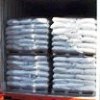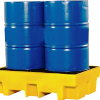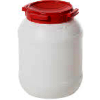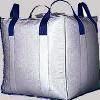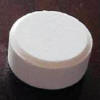Ammonium Chloride USP BP IP ACS Analytical Reagent FCC Food Grade Manufacturers, India
Anmol Chemicals are manufacturers of Specialty Chemicals and Pharmaceutical Excipients, in India. Anmol Chemicals Group has manufacturing facilities spread across India, representatives in Houston Chicago USA and toll manufacturers in China. We make IP, BP, USP, Ph Eur, FCC or Food Grade, ACS, AR or Analytical Reagent Grade, LR or Laboratory Reagent Grade and Pure Grades of various chemicals. All our items are analyzed to meet the required standards.
Our manufacturing facility is FDA GMP approved and ISO-9001, ISO 14000, OHSAS 18000, ISO 22000, FSSAI HACCP certified. We are offering products manufactured as per Kosher and Halal approved method. We are pre-registered with "Reach" for export to European countries.
Synonyms: Sal Ammoniac, Cloruro de Amonio, Cloruro Amonico
CAS No.: 7646-85-7, Molecular Weight: 53.5, Chemical Formula: NH4Cl

Ammonium Chloride IP
Description: Colorless crystals or white crystalline powder.
Solubility: Freely soluble in water; sparingly soluble in ethanol.
Assay: Content not less than 99% and not more than 100.5% of NH4Cl
calculated on dry basis.
Clarity and color of solution: A 10% w/w solution is clear & colorless.
pH of 5% solution: 4.5 to 6.0.
Arsenic: 4 ppm maximum
Heavy Metals: 10 ppm maximum.
Magnesium & alkali salts: 1% maximum
Iron: 20 ppm maximum
Sulfate: 150 ppm maximum
Sulfated ash: 0.1% maximum
Calcium: 200 ppm maximum
Thiocyanate: To pass the test
Loss on drying @105C: 1% maximum
Ammonium Chloride USP
NH4Cl 53.49
Assay— Ammonium Chloride contains not less than 99.5 percent and not more than 100.5 percent of NH4Cl, calculated on the dried basis.
Packaging and storage— Preserve in tight containers.
Identification— A solution (1 in 10) responds to the tests for Ammonium and for Chloride
pH: between 4.6 and 6.0, in a solution (1 in 20).
Loss on drying— Dry it over silica gel for 4 hours: it loses not more than 0.5% of its weight.
Residue on ignition— Add 1 mL of sulfuric acid to about 2 g, accurately weighed, and heat the mixture gently until volatilization is complete: the residue is
white, and when ignited, not more than 0.1% of nonvolatile substance remains.
Limit of thiocyanate— Acidify 10 mL of a solution (1 in 10) with hydrochloric acid, and add a few drops of ferric chloride TS: no orange-red color is produced.
Heavy metals: 0.001%.
Ammonium Chloride BP
NH4Cl
DEFINITION
Content or Assay
99.0 per cent to 100.5 per cent (On dried substance basis).
CHARACTERS
Appearance
White or almost white, crystalline powder or colorless crystals.
Solubility
Freely soluble in water.
IDENTIFICATION
A. It gives the reactions of chlorides.
B. 10 ml of solution gives the reaction of ammonium salts.
TESTS
Solution S
A 10% solution:
Appearance of solution: Solution is clear and colorless.
Acidity or alkalinity: To 10 ml of solution S add 0.05 ml of methyl red solution. Not more than 0.5 ml of 0.01 M hydrochloric acid or
0.01 M sodium hydroxide is required to change the color of the indicator.
Bromides and iodides: To 10 ml of solution S add 0.1 ml of dilute hydrochloric acid R and 0.05 ml of chloramine solution. After 1 min,
add 2 ml of chloroform R and shake vigorously. The chloroform layer remains colorless.
Sulphates: Maximum 150 ppm.
Calcium: Maximum 200 ppm.
Iron: Maximum 20 ppm.
Heavy metals: Maximum 10 ppm.
Loss on drying: Maximum 1.0 per cent, determined on 1.00 g by drying in an oven at 105 °C for 2 h.
Sulphated ash: Maximum 0.1 per cent, determined on 2.0 g.
Ammonium Chloride FCC Food Grade
NH4Cl Formula wt 53.49
DESCRIPTION
Ammonium Chloride occurs as colorless crystals or as a white, fine or coarse, crystalline powder. It is somewhat hygroscopic. One gram dissolves in
2.6 mL of water at 25°, in 1.4 mL of boiling water, in about 100 mL of alcohol, and in about 8 mL of glycerin. The pH of a 1:20 solution is between 4.5 and 6.0.
Identification: A 1:10 aqueous solution gives positive tests for Ammonium and for Chloride.
Assay: Not less than 99.0% of NH4Cl after drying.
Lead: Not more than 4 mg/kg.
Loss on Drying: Not more than 0.5%.
Ammonium Chloride ACS Analytical Reagent
American Chemical Society Analytical Reagent Grade
NH4Cl Formula Wt 53.49
CAS Number 12125–02–9
REQUIREMENTS
Assay . . . . . . .: ≥99.5% NH4Cl
pH of a 5% solution: 4.5–5.5 at 25 °C
MAXIMUM ALLOWABLE
Insoluble matter . . .: 0.005%
Residue after ignition: 0.01%
Calcium (Ca) . . . . .: 0.001%
Magnesium (Mg) . . . .: 5 ppm
Heavy metals (as Pb) .: 5 ppm
Iron (Fe) . . . . . . : 2 ppm
Phosphate (PO4). . . .: 2 ppm
Sulfate (SO4). . . . .: 0.002%

Manufacturers
ANMOL CHEMICALS
S-8, SARIFA MANSION, 2ND PRINCIPAL SHAIKH HASAN MARG, MUMBAI 400009, INDIA
TEL: (OFF) 91-22-23726950, 23774610, 23723564. FAX: 91-22-23728264
e-mail: info@anmol.org
Copyright and Usual Disclaimer is Applicable
Exporters to USA, UAE, Europe, South Africa, Tanzania, Kenya, Egypt, Turkey, Nigeria, Uganda, Brazil, Chile, Argentina, Dubai etc.
Representatives in New York, Houston - Texas, Chicago - Illinois, Los Angeles.
Fast Selling IP BP USP ACS FCC Food Grades of Chemicals by Anmol Chemicals
Aluminum Chloride ---------- Ammonium Sulfate ----- Ammonium Persulfate
Aluminum Potassium Sulfate - Ammonium Chloride ---- Ammonium Bicarbonate
Ammonium Carbonate --------- Benzyl Alcohol ------- Boric Acid
Benzoic Acid --------------- Borax; Sodium Borate - Calcium Chloride
Calcium Hydroxide ---------- Calcium Acetate ------ Calcium Butyrate
Calcium Lactobionate ------- Calcium Levulinate --- Calcium Saccharate
Carbamide Peroxide --------- Citric Acid ---------- Calcium Phosphate
Calcium Oxide -------------- Calcium Sulfate ------ Chromic Chloride
Cupric Chloride ------------
Ferric Chloride ------------ Ferric Nitrate ------- Fumaric Acid
Gentian Violet ------------- Glacial Acetic Acid
Lactobionic Acid ----------- Magnesium Butyrate
Magnesium Oxide ------------ Magnesium Chloride --- Magnesium Sulfate
Malic Acid ----------------- Maleic Acid ---------- Manganese Chloride
Manganese Sulfate ---------- Methylene Blue ------- Oleic Acid
Octyldodecanol -------------
Propylene Carbonate -------- Potassium Acetate ---- Potassium Carbonate
Potassium Hydroxide -------- Potassium Chloride --- Potassium Phosphate
Potassium Bitartrate ------- Propylene Carbonate -- Selenious acid
Sodium Molybdate ----------- Sodium Perborate ----- Sodium Phosphate
Sodium Propionate ---------- Sodium Acetate ------- Sodium Bicarbonate
Sodium Hydroxide ----------- Sodium Chloride ------ Sodium Thiosulfate
Sodium Selenite ------------ Urea ----------------- Zinc Chloride
Other Best Selling Products
Ammonium Bromide ----------- Ammonium Phosphate --- Barium Chloride
Butylated Hydroxyanisole --- Butylated Hydroxytoluene
Calcium Nitrate Nitrite ---- Calcium Propionate --- Copper Sulfate
Ceric Ammonium Nitrate ----- Cinnamaldehyde ------- Isatoic Anhydride
Directly Compressible Calcium Carbonate ----------- Encapsulated Citric Acid
Encapsulated Fumaric Acid -- Encapsulated Sodium Bicarbonate -
Encapsulated Sorbic Acid
Potassium Bromide ---------- Potassium Iodide ----- Potassium Nitrate Nitrite
Sodium Bromate ------------- Skatole -------------- Sodium Butyrate
Sodium Nitrite & Nitrate --- Sodium Bromide ------- Sodium Diacetate
Sodium Formaldehyde Bisulfite Strontium Chloride -- Stannous Chloride
TBHQ Tertiary Butylhydroquinone







